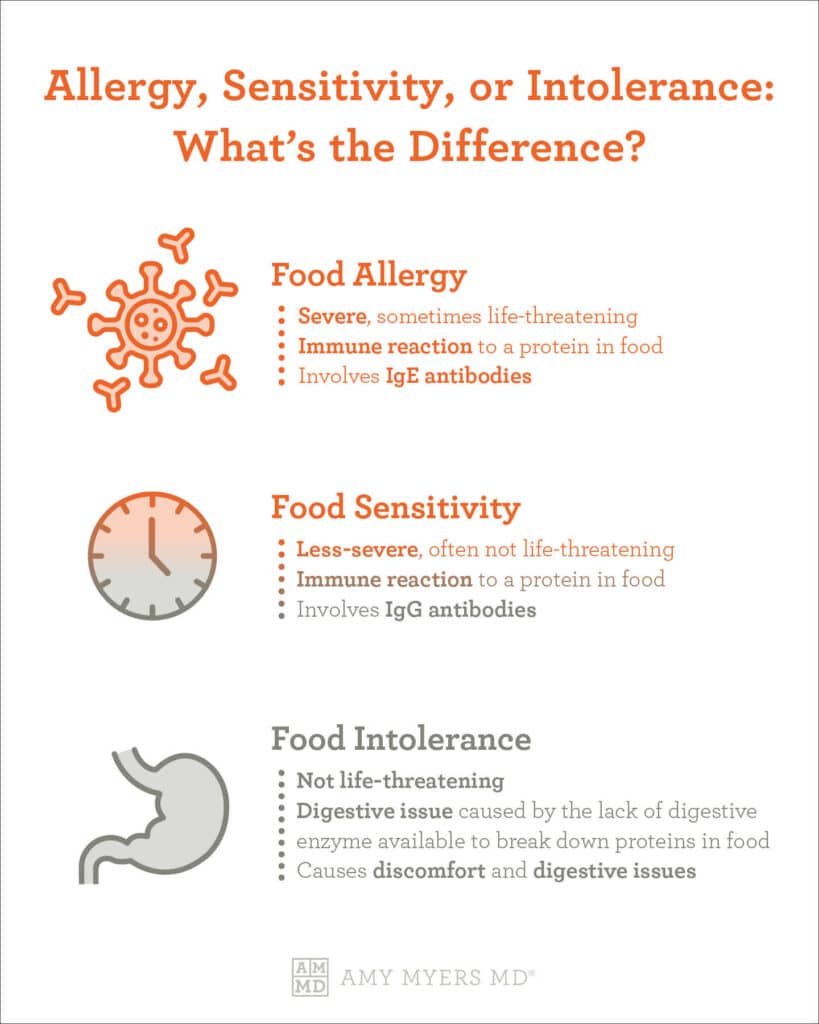There are a lot of words being thrown around when it comes to reactions to certain foods – allergy, sensitivity, and intolerance. Yet, not many people know the difference between a food allergy and food intolerance. Some of you may not even know the difference between a food sensitivity and food allergy.
Food allergies are, in most cases, fairly easy to detect. You’ll have an obvious reaction that happens immediately or shortly after being exposed. Food sensitivities are not as easy to detect and may take up to 72 hours to notice any symptoms. Lastly, food intolerances are easy to disregard because the symptoms are mostly digestive issues. That includes bloating, diarrhea, stomach discomfort, indigestion, and nausea.
I understand that all of this is a bit confusing. Don’t worry. I’m going to break down the difference between a food allergy and food intolerance, and also the difference between a food allergy and food sensitivity and give you the tools to take back your health. Let’s begin by breaking down each one.
The Causes of Food Reactions
The general difference between a food allergy and food intolerance is what’s causing the reaction to certain foods. In order to understand the difference between a food allergy and food intolerance, as well as a food sensitivity, it’s important to know the ins and outs of each. Let’s begin with what is a food allergy.
 Dr. Amy Myers
May 1st, 2022
https://content.amymyersmd.com/article/difference-food-allergy-food-sensitivity-intolerance/The Difference Between Food Allergy And Food Intolerance – Infographic – Amy Myers MD®
Dr. Amy Myers
May 1st, 2022
https://content.amymyersmd.com/article/difference-food-allergy-food-sensitivity-intolerance/The Difference Between Food Allergy And Food Intolerance – Infographic – Amy Myers MD®What is the Definition of a Food Allergy?
You may have or know someone that has a food allergy to certain foods such as milk, tree nuts, peanuts, or shellfish. Food allergies are not as common as you might think. It’s estimated that only 8% of children under the age of 5 and up to 4% of adults have a food allergy. The most common food allergies are milk, eggs, fish, shellfish, tree nuts, peanuts, wheat, and soy.
Symptoms of a Food Allergy
For some people, symptoms are not severe and just cause discomfort. However, in some cases a food allergy reaction can be life threatening. This is one of the most common differences between a food allergy and food sensitivity. A sensitivity and intolerance are not life threatening. Common symptoms of a food allergy include: 1
- Tingling or itching in the mouth
- Hives, itching, or eczema
- Swelling of the lips, face, tongue
- Wheezing, nasal congestion, or trouble breathing
- Abdominal pain, diarrhea, nausea, or vomit
- Dizziness, lightheadedness, or fainting
- Anaphylaxis
Causes of a Food Allergy
One of the key differences between a food allergy, a food sensitivity, and a food intolerance is what causes the reaction. For example, your immune system is what causes a reaction when you have a food allergy or a food sensitivity. Your gut is behind a food intolerance. I’ll explain more in a bit.
In common food allergies such as that to strawberries or milk, your immune system targets a protein in that food as a foreign invader. An antibody known as immunoglobulin E (IgE) mistakes the protein as a threat and releases histamines.
Histamines are behind the swelling, itchiness, and the production of mucus in defense of this protein. With anaphylaxis, the IgE antibody releases very large amounts of histamine into your blood. This can cause you to feel lightheaded or lose consciousness, have clammy skin, a fast heartbeat, trouble breathing. Anaphylaxis is life threatening and is considered a medical emergency.
What is the Definition of a Food Sensitivity?
As I mentioned, one of the common differences between a food allergy, a food sensitivity, and food intolerance is what causes the reaction. While the immune system is what causes the reaction in both a food allergy and a food sensitivity, the difference is the antibody that causes the reaction.
Food sensitivities and food intolerances are much more common than food allergies. It’s estimated that 20% of the world’s population has a food sensitivity or intolerance.2 I believe that number is much higher because of how tricky they are to discover. I’ll talk more about that in just a minute.
Symptoms of a Food Sensitivity
Food sensitivity symptoms are similar to that of an allergy, however a food sensitivity is not life threatening.The tricky part is that because it’s the Immunoglobulin G (IgG) that attacks the protein, symptoms can take up to 72 hours to be noticed. The IgG antibody response is delayed. By the time you have a response, it’s almost impossible to go back through the list of everything you ate to determine the food causing the problem.3 Symptoms are similar to a food allergy, yet also include digestive issues such as bloating and abdominal pain.
Causes of a Food Sensitivity
Gluten is the most common food sensitivity in the world. It is a protein found in wheat that is made up of gliadin and glutenin. While gluten sensitivity and Celiac disease are often used interchangeably, Celiac disease only affects 1% of the U.S. population.4 You can be sensitive to gluten and not have Celiac disease.
While gluten is the most common food sensitivity, it’s hardly the only one. Many people develop sensitivities to citrus fruits, nightshades, cow’s dairy, soy, legumes, and tree nuts. As with a food allergy, your immune system views a protein as a threat. When you have a food sensitivity, the protein triggers an Immunoglobulin G (IgG) response instead of an IgE response.
What makes it tricky, is that an IgG response is delayed, so you may not realize a food is causing your symptoms until long after you ate it. Don’t worry, I’ll tell you what testing methods I recommend for food sensitivities and food allergies later. Before I do that, let me tell you the difference between a food intolerance and a food sensitivity.
Food Intolerance vs Food Sensitivity
As I mentioned earlier, the difference between these three reactions to food is what’s causing it. With a food intolerance, your gut is causing the reaction to certain foods. This could be because you’ve stopped producing the digestive enzyme that allows you to break down certain foods.
Another difference is where the symptoms originate. Unlike a food allergy and food sensitivity, symptoms of a food intolerance are mostly exclusive to digestive issues such as bloating, diarrhea, vomiting, nausea, abdominal pain, gas or bloating, or an upset stomach.
The list of foods are also similar, however can include beef, pork, and lamb, coffee, alcohol, corn, and fermentable foods such as grapes and cherries.
A Note About Gluten And Dairy
It is more common for you to have an intolerance to gluten than a sensitivity. As a matter of fact, nearly 18 million people in the United States are intolerant to gluten.5 That’s about six times more people than that who have celiac disease.
Dairy is the second most common food intolerance. For a lot of people, their gut stops producing the enzyme Lactase, which helps break down lactose, a sugar found in dairy. This is not the same as an allergy to cow’s dairy, which is usually triggered by a reaction to the proteins whey and casein. However, casein is not easy to digest for some people and causes inflammation.
Gluten and casein also have a similar molecular structure, so your body cannot tell one from the other. If you are intolerant or sensitive to gluten, you are also likely to have an intolerance or sensitivity to dairy.
Food Allergy and Food Sensitivity Testing
If you suspect you have a food allergy, I recommend talking with your functional medicine practitioner to get the proper testing. As for testing for a food sensitivity or intolerance, the most tried and true way to determine if you have a food sensitivity or intolerance is by following an elimination diet.
An elimination diet involves removing specific foods for a short period of time, usually 30 days. After 30 days, you then enter the reintroduction phase and reintroduce these foods one by one while tracking your symptoms.
However, I know that you may want instant results or to see numbers. There are so many food sensitivity tests on the market these days. An IgG food sensitivity test is a good way to find out if you have a food sensitivity, however they may not be completely accurate. Remember, you may not have a sensitivity or intolerance to a certain food and still could be intolerant.
If you want to test for a gluten sensitivity or celiacs disease, I recommend using Lets Get Checked.You can do the test in the privacy of your own home.
If you determine that you have an intolerance to foods, adding digestive enzymes can support proper digestion and optimal gut health. I’m about to tell you why supplementing with digestive enzymes is essential as you get older, especially if you have a food intolerance.
Digestive Enzymes And Aging
As I mentioned, a food intolerance occurs when your body loses the enzyme to break down food properly. As you get older, digestive enzyme production slows down and in some cases, stops altogether. This impacts your entire digestive health and makes it hard to absorb nutrients from food.
Here are some signs that indicate you’re not digesting food properly:
- Bulky, foul-smelling stools
- Feeling full, even if you haven’t overeaten
- Gas, bloating, or flatulence
- Heartburn or burping
- Lack of energy
- Undigested food in stool
- Weight loss even while eating an optimal diet
Adding Digestive Enzymes
If after following an elimination diet and discovering a food intolerance, I recommend the following supportive measures:
- Add Complete Enzymes
- Eliminate foods you are intolerant to as much as possible
- Chew well and eat slowly
- Consume fruits and vegetables
- Don’t eat late at night
- Ditch processed foods
My Complete Enzymes are perfect for anyone who wants the very best digestive enzyme available that is equipped to break down a broad spectrum of foods and assist with optimal absorption and utilization of micronutrients.
I recommend it for anyone concerned about food intolerances or is looking to manage accidental gluten exposure and cross-contamination because it contains protease enzymes with powerful DPP-IV activity to break down gluten. I have a bottle of Complete Enzymes with me whenever I go to a restaurant or eat at a friend or family’s home. Just in case I accidentally get glutened.
Complete Enzymes support your body’s inflammatory response, immune system, and digestive health, and they are made with no animal-based ingredients whatsoever! Support your journey to optimal health by improving your digestion so that you can absorb all the nutrients in your food.
Knowing the difference between food allergy and food intolerance, as well as what is causing your reaction to certain foods can help you get to the root of your symptoms and take back your health. Adding Complete Enzymes to support proper digestion and promote nutrient absorption can help you achieve optimal health.

Article Sources
- Food Allergy: An Overview. Mayo Clinic. 2021.
- The Differential Diagnosis of Food Intolerance . Dr. Zoph Yurdagül, et al. Deutches Arzteblatt International. 2009.
- Food allergy, intolerance, or sensitivity: What’s the difference, and why does it matter?. By Marcelo Campos, MD, Contributor . Harvard Health. 2020.
- Celiac Disease: An Overview. Mayo Clinic. 2021.
- Non-Celiac Gluten Sensitivity. Beyond Celiac. 2021.
